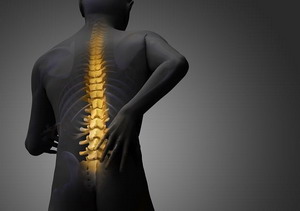 We don’t like pain. That is a good thing, we aren’t supposed to like pain. Pain is the message our body uses to tell us something is wrong. If the pain is intense then it is telling us we need to do something about this problem right now. Some sort of damage is taking place and we need to do something to stop the damage. This warning system seems really simple like the smoke detectors in our house. So the question becomes, why do we try to shut off the warning system instead of attending to whatever is causing damage to our bodies? If our smoke detector goes off, do we simply take out the battery without looking for a fire? Of course not. That would be silly.
We don’t like pain. That is a good thing, we aren’t supposed to like pain. Pain is the message our body uses to tell us something is wrong. If the pain is intense then it is telling us we need to do something about this problem right now. Some sort of damage is taking place and we need to do something to stop the damage. This warning system seems really simple like the smoke detectors in our house. So the question becomes, why do we try to shut off the warning system instead of attending to whatever is causing damage to our bodies? If our smoke detector goes off, do we simply take out the battery without looking for a fire? Of course not. That would be silly.
 And yet every month between 5% and 20% of our US population pops pain pills to “take the battery out of their smoke detectors in their body.” The older we get the more often we reach for those painkillers. How often do we look for the fire and put that out instead? What happens when we ignore those fires and simply shut off the alarms? As you might guess, things happen that are not so good. But even beyond not taking care of the real source of the pain is the issue of the damage being caused by the painkillers themselves. There is typically some level of toxicity to prescription and over-the-counter painkillers. The first medical painkillers were opium and morphine. The severe addiction issues these caused have followed us into the present day with the “opioid crisis.” Medicine simply got better at creating synthetic versions of opium that were far more dangerous.
And yet every month between 5% and 20% of our US population pops pain pills to “take the battery out of their smoke detectors in their body.” The older we get the more often we reach for those painkillers. How often do we look for the fire and put that out instead? What happens when we ignore those fires and simply shut off the alarms? As you might guess, things happen that are not so good. But even beyond not taking care of the real source of the pain is the issue of the damage being caused by the painkillers themselves. There is typically some level of toxicity to prescription and over-the-counter painkillers. The first medical painkillers were opium and morphine. The severe addiction issues these caused have followed us into the present day with the “opioid crisis.” Medicine simply got better at creating synthetic versions of opium that were far more dangerous.
 The next popular painkiller was the invention of a synthetic aspirin compound. This has been known to cause intestinal bleeding for over 100 years. Some medical forensic specialists believe that the massive death rate from the great flu epidemic of 1917 was actually caused by folks massively overdosing on aspirin. The pathology reports from those days perfectly match what happens to people’s lungs when they overdose on aspirin. Back then aspirin was the new wonder drug to replace opiates, and no proper dosage had been figured out yet. People were just told to take aspirin as needed for the aches and chills of the flu.
The next popular painkiller was the invention of a synthetic aspirin compound. This has been known to cause intestinal bleeding for over 100 years. Some medical forensic specialists believe that the massive death rate from the great flu epidemic of 1917 was actually caused by folks massively overdosing on aspirin. The pathology reports from those days perfectly match what happens to people’s lungs when they overdose on aspirin. Back then aspirin was the new wonder drug to replace opiates, and no proper dosage had been figured out yet. People were just told to take aspirin as needed for the aches and chills of the flu.
 A more recent painkiller debacle came with the latest wonder painkiller Vioxx. This was a newer NSAID type of medication – a non-steroidal anti-inflammatory drug. It was approved back in 1998, but by 1999 so many folks had died of heart attacks from taking Vioxx that it was taken off the market. At that time 27000 people were killed by taking Vioxx. The problem we have today is that other NSAIDs like the older naproxen (Aleve), and ibuprofen (Motrin and Advil) are just as dangerous. They damage hearts, and kidneys, and cause GI bleeding. The other popular pain killer is acetaminophen (Tylenol) which is so toxic to the liver that it is the main cause of liver failure in the US. Over 200,000 liver transplants each year are needed because of using Tylenol. The marketing of these drugs has convinced the public that they are very safe when in fact they are very dangerous. In low and infrequent doses the body can detoxify these drugs. Using one for a headache once a month is fine, but using these for chronic pain regularly is like playing with a loaded gun.
A more recent painkiller debacle came with the latest wonder painkiller Vioxx. This was a newer NSAID type of medication – a non-steroidal anti-inflammatory drug. It was approved back in 1998, but by 1999 so many folks had died of heart attacks from taking Vioxx that it was taken off the market. At that time 27000 people were killed by taking Vioxx. The problem we have today is that other NSAIDs like the older naproxen (Aleve), and ibuprofen (Motrin and Advil) are just as dangerous. They damage hearts, and kidneys, and cause GI bleeding. The other popular pain killer is acetaminophen (Tylenol) which is so toxic to the liver that it is the main cause of liver failure in the US. Over 200,000 liver transplants each year are needed because of using Tylenol. The marketing of these drugs has convinced the public that they are very safe when in fact they are very dangerous. In low and infrequent doses the body can detoxify these drugs. Using one for a headache once a month is fine, but using these for chronic pain regularly is like playing with a loaded gun.
 An intelligent person might ask why are we selling such dangerous drugs to the public that have such proven negative ‘side’ effects. (Side effects is one of those marketing terms used to manipulate you. There are no ‘side’ effects, only effects – some wanted and some not wanted.) A quote I read recently answered that question nicely. When something does not make sense in the medical world, just follow the money. It is money, not health that dictates medical policy. Each liver transplant costs the insurance company/government/public almost a million dollars. Who could possibly benefit from $200,000,000,000 of expenses for Tylenol’s “side effects?”, Yes, you read that right, 200 billion. I don’t have any numbers on the costs of the heart, kidney, or GI damage being caused.
An intelligent person might ask why are we selling such dangerous drugs to the public that have such proven negative ‘side’ effects. (Side effects is one of those marketing terms used to manipulate you. There are no ‘side’ effects, only effects – some wanted and some not wanted.) A quote I read recently answered that question nicely. When something does not make sense in the medical world, just follow the money. It is money, not health that dictates medical policy. Each liver transplant costs the insurance company/government/public almost a million dollars. Who could possibly benefit from $200,000,000,000 of expenses for Tylenol’s “side effects?”, Yes, you read that right, 200 billion. I don’t have any numbers on the costs of the heart, kidney, or GI damage being caused.
 What are we to do? From my perspective, the first step is to look for the fires and put them out. Most fires in the body show up as inflammation. The most common use of painkillers is for back, muscle, and joint pain. That is what keeps me in business. My patients get tired of just taking a pain pill for their pain and want to get to the cause. This usually amounts to muscle and joint imbalances that start as minor injuries that just gradually become larger problems. Other times the problem is muscle imbalances caused by work postures or lack of sufficient exercise. Surprisingly, a very common cause for low back issues is referred pain from gut inflammation. Food sensitivities trigger 80% of migraines. About 50% of other types of headaches can be traced back to blood sugar imbalances. Other headaches can be due to constricted blood flow. The most common cause of neck pain is computer/cell phone use. All these kinds of things can be addressed without adopting a lifestyle of popping pain pills.
What are we to do? From my perspective, the first step is to look for the fires and put them out. Most fires in the body show up as inflammation. The most common use of painkillers is for back, muscle, and joint pain. That is what keeps me in business. My patients get tired of just taking a pain pill for their pain and want to get to the cause. This usually amounts to muscle and joint imbalances that start as minor injuries that just gradually become larger problems. Other times the problem is muscle imbalances caused by work postures or lack of sufficient exercise. Surprisingly, a very common cause for low back issues is referred pain from gut inflammation. Food sensitivities trigger 80% of migraines. About 50% of other types of headaches can be traced back to blood sugar imbalances. Other headaches can be due to constricted blood flow. The most common cause of neck pain is computer/cell phone use. All these kinds of things can be addressed without adopting a lifestyle of popping pain pills.
 Many times we are able to find the cause of inflammation in the body, but the conditions have progressed so far that it is going to take some serious lifestyle work and time to put the fires out. In these situations, I see taking various natural non-toxic pain fighters and anti-inflammatory agents to be very useful. For instance, right after an acute injury taking arnica is excellent for knocking down pain and swelling. For strained muscles and inflamed joints using heat followed by cold for 15 minutes each does wonders for the inflammation. Gels and lotions that feel hot or cold can help block the pain in the immediate area. For more body-wide discomfort conditions my personal choices are to use CBD caps and/or white willow bark capsules. When I am dealing with chronic fibrotic tight tissues, I will recommend a systemic enzyme like lumbrokinase or serrapeptase. Probably the most powerful systemic anti-inflammatory is curcumin found in the turmeric root. This is terrific for brain inflammation.
Many times we are able to find the cause of inflammation in the body, but the conditions have progressed so far that it is going to take some serious lifestyle work and time to put the fires out. In these situations, I see taking various natural non-toxic pain fighters and anti-inflammatory agents to be very useful. For instance, right after an acute injury taking arnica is excellent for knocking down pain and swelling. For strained muscles and inflamed joints using heat followed by cold for 15 minutes each does wonders for the inflammation. Gels and lotions that feel hot or cold can help block the pain in the immediate area. For more body-wide discomfort conditions my personal choices are to use CBD caps and/or white willow bark capsules. When I am dealing with chronic fibrotic tight tissues, I will recommend a systemic enzyme like lumbrokinase or serrapeptase. Probably the most powerful systemic anti-inflammatory is curcumin found in the turmeric root. This is terrific for brain inflammation.
 The world of herbology is filled with powerful natural substances that can tame inflammation and reduce pain. These herbs have been found to work as well or better than ibuprofen. They include such plants as thyme, cinnamon, ginger, clove, peppermint, and even olive oil. Other foods are powerful inflammation fighters like omega-3 fish oil, green tea, and the polyphenols in berries. There are many more herbs that are used in more specific cases, which are best evaluated by a good herbalist. The goal here is to put out the fires that are triggering the cries for help the body is giving us in the form of pain. Solve the problem and the pain goes away on its own.
The world of herbology is filled with powerful natural substances that can tame inflammation and reduce pain. These herbs have been found to work as well or better than ibuprofen. They include such plants as thyme, cinnamon, ginger, clove, peppermint, and even olive oil. Other foods are powerful inflammation fighters like omega-3 fish oil, green tea, and the polyphenols in berries. There are many more herbs that are used in more specific cases, which are best evaluated by a good herbalist. The goal here is to put out the fires that are triggering the cries for help the body is giving us in the form of pain. Solve the problem and the pain goes away on its own.
 All that being said, I can say from personal experience of being wheeled into emergency with a trapped kidney stone that had to be extracted surgically that I was never so grateful for anything as much as that injection of morphine to kill my pain. There are times when powerful painkillers are very needed. I would not have been happy with a handful of herbs and a pat on the back. The doctors figured out the source of the pain and set me up to have the issue dealt with. But in the meantime, thank goodness for the drugs!
All that being said, I can say from personal experience of being wheeled into emergency with a trapped kidney stone that had to be extracted surgically that I was never so grateful for anything as much as that injection of morphine to kill my pain. There are times when powerful painkillers are very needed. I would not have been happy with a handful of herbs and a pat on the back. The doctors figured out the source of the pain and set me up to have the issue dealt with. But in the meantime, thank goodness for the drugs!
 There are definitely two sides to the painkiller story. Putting out the fires in the body is the best option, but this usually takes time. It also takes commitment to change. Pain is a good motivator for change, but not always enough. Changing one’s lifestyle is hard and needs to be done a little bit at a time for most folks. Where are lifestyle is right now is usually a consequence of trying to balance lots of conflicting needs and demands. If this were easy, there would not be hundreds of best-selling self-help books published every year and endless blogs and videos offered by self-help gurus. I don’t have any easy answers, just the awareness that when the body cries out in pain, something different needs to be done. At that point, our journey begins…
There are definitely two sides to the painkiller story. Putting out the fires in the body is the best option, but this usually takes time. It also takes commitment to change. Pain is a good motivator for change, but not always enough. Changing one’s lifestyle is hard and needs to be done a little bit at a time for most folks. Where are lifestyle is right now is usually a consequence of trying to balance lots of conflicting needs and demands. If this were easy, there would not be hundreds of best-selling self-help books published every year and endless blogs and videos offered by self-help gurus. I don’t have any easy answers, just the awareness that when the body cries out in pain, something different needs to be done. At that point, our journey begins…
Take care,
David
Ellen
We have some excitement today! Our ice cream machine just arrived. The new sugar, allulose, has prompted me to find a way to make our own ice cream that includes allulose. I have only found a couple commercial ice creams that sweeten with allulose, and they are not the flavors we like. I was never able to get my homemade coconut milk ice cream made with erythritol soft enough to be served like ice cream should be served. We are excited to try this new ice cream maker with this new sweetener.
